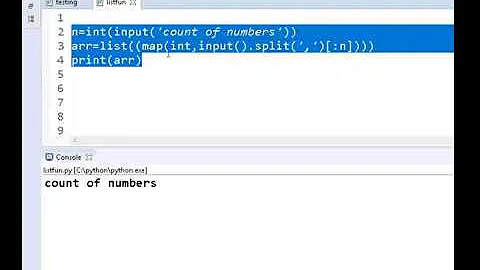How can I read inputs as numbers?
Solution 1
Solution
Since Python 3, input returns a string which you have to explicitly convert to ints, with int, like this
x = int(input("Enter a number: "))
y = int(input("Enter a number: "))
You can accept numbers of any base and convert them directly to base-10 with the int function, like this
>>> data = int(input("Enter a number: "), 8)
Enter a number: 777
>>> data
511
>>> data = int(input("Enter a number: "), 16)
Enter a number: FFFF
>>> data
65535
>>> data = int(input("Enter a number: "), 2)
Enter a number: 10101010101
>>> data
1365
The second parameter tells what is the base of the numbers entered and then internally it understands and converts it. If the entered data is wrong it will throw a ValueError.
>>> data = int(input("Enter a number: "), 2)
Enter a number: 1234
Traceback (most recent call last):
File "<input>", line 1, in <module>
ValueError: invalid literal for int() with base 2: '1234'
For values that can have a fractional component, the type would be float rather than int:
x = float(input("Enter a number:"))
Differences between Python 2 and 3
Summary
- Python 2's
inputfunction evaluated the received data, converting it to an integer implicitly (read the next section to understand the implication), but Python 3'sinputfunction does not do that anymore. - Python 2's equivalent of Python 3's
inputis theraw_inputfunction.
Python 2.x
There were two functions to get user input, called input and raw_input. The difference between them is, raw_input doesn't evaluate the data and returns as it is, in string form. But, input will evaluate whatever you entered and the result of evaluation will be returned. For example,
>>> import sys
>>> sys.version
'2.7.6 (default, Mar 22 2014, 22:59:56) \n[GCC 4.8.2]'
>>> data = input("Enter a number: ")
Enter a number: 5 + 17
>>> data, type(data)
(22, <type 'int'>)
The data 5 + 17 is evaluated and the result is 22. When it evaluates the expression 5 + 17, it detects that you are adding two numbers and so the result will also be of the same int type. So, the type conversion is done for free and 22 is returned as the result of input and stored in data variable. You can think of input as the raw_input composed with an eval call.
>>> data = eval(raw_input("Enter a number: "))
Enter a number: 5 + 17
>>> data, type(data)
(22, <type 'int'>)
Note: you should be careful when you are using input in Python 2.x. I explained why one should be careful when using it, in this answer.
But, raw_input doesn't evaluate the input and returns as it is, as a string.
>>> import sys
>>> sys.version
'2.7.6 (default, Mar 22 2014, 22:59:56) \n[GCC 4.8.2]'
>>> data = raw_input("Enter a number: ")
Enter a number: 5 + 17
>>> data, type(data)
('5 + 17', <type 'str'>)
Python 3.x
Python 3.x's input and Python 2.x's raw_input are similar and raw_input is not available in Python 3.x.
>>> import sys
>>> sys.version
'3.4.0 (default, Apr 11 2014, 13:05:11) \n[GCC 4.8.2]'
>>> data = input("Enter a number: ")
Enter a number: 5 + 17
>>> data, type(data)
('5 + 17', <class 'str'>)
Solution 2
In Python 3.x, raw_input was renamed to input and the Python 2.x input was removed.
This means that, just like raw_input, input in Python 3.x always returns a string object.
To fix the problem, you need to explicitly make those inputs into integers by putting them in int:
x = int(input("Enter a number: "))
y = int(input("Enter a number: "))
Solution 3
For multiple integer in a single line, map might be better.
arr = map(int, raw_input().split())
If the number is already known, (like 2 integers), you can use
num1, num2 = map(int, raw_input().split())
Solution 4
input() (Python 3) and raw_input() (Python 2) always return strings. Convert the result to integer explicitly with int().
x = int(input("Enter a number: "))
y = int(input("Enter a number: "))
Solution 5
Multiple questions require multiple integers to be entered on a single line. The best way is to enter the entire string of numbers line by line and split them into integers. Here is the Python 3 version:
a = []
p = input()
p = p.split()
for i in p:
a.append(int(i))
You can also use list comprehensions:
p = input().split("whatever the seperator is")
To convert all input from string to int we do the following:
x = [int(i) for i in p]
print(x, end=' ')
List elements should be printed in straight lines.
Related videos on Youtube
Comments
-
smci almost 2 years
Why are
xandystrings instead of ints in the below code?(Note: in Python 2.x use
raw_input(). In Python 3.x useinput().raw_input()was renamed toinput()in Python 3.x)play = True while play: x = input("Enter a number: ") y = input("Enter a number: ") print(x + y) print(x - y) print(x * y) print(x / y) print(x % y) if input("Play again? ") == "no": play = False-
 Patrick Artner over 5 years
Patrick Artner over 5 years
-
-
 Admin almost 10 yearsThis looks very interesting. However, isn't
Admin almost 10 yearsThis looks very interesting. However, isn'tidestroyed when theforloop is exited? -
Aravind almost 10 years
@hosch250When a loop is exited, the value of the index variable (here,i) remains. I tried this piece out, and it works correctly. -
 Shreyan Mehta about 8 yearsIs there any other way, like a function or something so that we dont need to convert to int in 3.x other than doing explicit conversion to int??
Shreyan Mehta about 8 yearsIs there any other way, like a function or something so that we dont need to convert to int in 3.x other than doing explicit conversion to int?? -
 thefourtheye about 8 years@ShreyanMehta
thefourtheye about 8 years@ShreyanMehtaevalwould work, but don't go for that unless you have pressing reasons. -
 spectras about 6 years@thefourtheye at least use
spectras about 6 years@thefourtheye at least useast.literal_evalfor that. It does not have the security concerns ofeval. -
 301_Moved_Permanently almost 6 yearsFor this kind of input manipulation, you can either
301_Moved_Permanently almost 6 yearsFor this kind of input manipulation, you can eithernum1, num2 = map(int, input().split())if you know how much integers you will encounter ornums = list(map(int, input().split()))if you don't.









